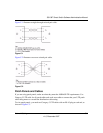
GS108T Smart Switch Software Administration Manual
B-2 Virtual Local Area Networks (VLANs)
v1.0, December 2007
IEEE 802.1Q VLANs
Packets received by the switch are treated in the following way:
• When an untagged packet enters a port, it is automatically tagged with the port’s default
VLAN ID tag number. Each port has a default VLAN ID setting that is user configurable (the
default setting is 1). The default VLAN ID setting for each port can be changed in the VLAN
Membership screen. See
“Advanced—VLAN Membership” on page 4-12.
• When a tagged packet enters a port, the tag for that packet is unaffected by the default VLAN
ID setting. The packet proceeds to the VLAN specified by its VLAN ID (VID) tag number.
• If the port through which the packet entered does not have membership with the VLAN
specified by the VLAN ID tag, the packet is dropped.
• If the port is a member of the VLAN specified by the packet’s VLAN ID, the packet can be
sent to other ports with the same VLAN ID.
• Packets leaving the switch are either tagged or untagged, depending on the setting for that
port’s VLAN membership properties. A U for a given port means that packets leaving the
switch from that port are untagged. Inversely, a T for a given port means that packets leaving
the switch from that port are tagged with the VLAN ID that is associated with the port.
The example given in this section comprises numerous steps to illustrate a wide range of
configurations to help provide an understanding of tagged VLANs.
IEEE 802.1Q VLAN Example Configuration
This example demonstrates several scenarios of VLAN use and describes how the switch handles
tagged and untagged traffic.
In this example, you create two new VLANS, you change the port membership for default
VLAN
1, and you assign port members to the two new VLANs:
1. In the Basic VLAN Configuration screen (see “Basic—VLAN Configuration” on page 4-9),
create the following VLANs:
– A VLAN with VID 10.
– A VLAN with VID 20.
2. In the VLAN Membership screen (see “Advanced—VLAN Membership” on page 4-12)
specify the VLAN membership as follows:
– For the default VLAN with VID 1, specify the following members: port 7 (U) and
port 8 (U).


















